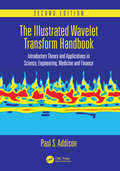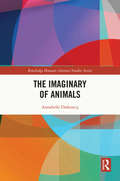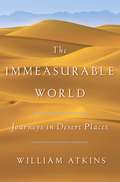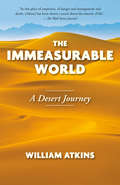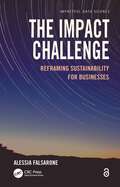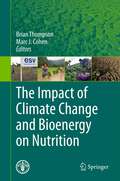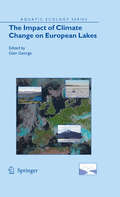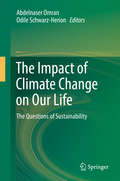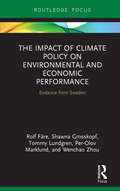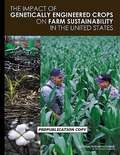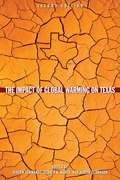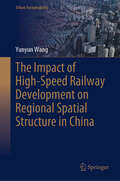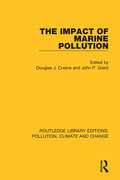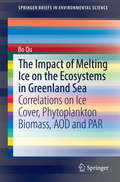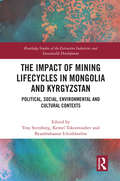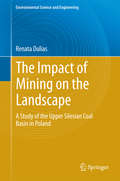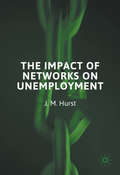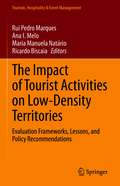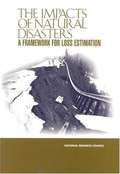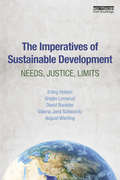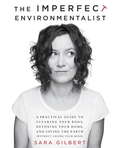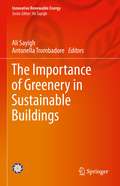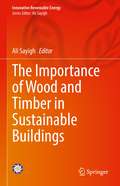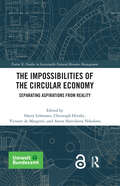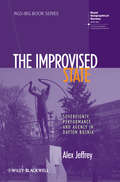- Table View
- List View
The Illustrated Wavelet Transform Handbook: Introductory Theory and Applications in Science, Engineering, Medicine and Finance, Second Edition
by Paul S. AddisonThis second edition of The Illustrated Wavelet Transform Handbook: Introductory Theory and Applications in Science, Engineering, Medicine and Finance has been fully updated and revised to reflect recent developments in the theory and practical applications of wavelet transform methods. The book is designed specifically for the applied reader in science, engineering, medicine and finance. Newcomers to the subject will find an accessible and clear account of the theory of continuous and discrete wavelet transforms, while readers already acquainted with wavelets can use the book to broaden their perspective. One of the many strengths of the book is its use of several hundred illustrations, some in colour, to convey key concepts and their varied practical uses. Chapters exploring these practical applications highlight both the similarities and differences in wavelet transform methods across different disciplines and also provide a comprehensive list of over 1000 references that will serve as a valuable resource for further study. Paul Addison is a Technical Fellow with Medtronic, a global medical technology company. Previously, he was co-founder and CEO of start-up company, CardioDigital Ltd (and later co-founded its US subsidiary, CardioDigital Inc) - a company concerned with the development of novel wavelet-based methods for biosignal analysis. He has a master’s degree in engineering and a PhD in fluid mechanics, both from the University of Glasgow, Scotland (founded 1451). His former academic life as a tenured professor of fluids engineering included the output of a large number of technical papers, covering many aspects of engineering and bioengineering, and two textbooks: Fractals and Chaos: An Illustrated Course and the first edition of The Illustrated Wavelet Transform Handbook. At the time of publication, the author has over 100 issued US patents concerning a wide range of medical device technologies, many of these concerning the wavelet transform analysis of biosignals. He is both a Chartered Engineer and Chartered Physicist.
The Imaginary of Animals (Routledge Human-Animal Studies Series)
by Annabelle DufourcqThis book explores the phenomenon of animal imagination and its profound power over the human imagination. It examines the structural and ethical role that the human imagination must play to provide an interface between humans’ subjectivity and the real cognitive capacities of animals. The book offers a systematic study of the increasing importance of the metaphors, the virtual, and figures in contemporary animal studies. It explores human-animal and real-imaginary dichotomies, revealing them to be the source of oppressive cultural structures. Through an analysis of creative, playful and theatric enactments and mimicry of animal behaviors and communication, the book establishes that human imagination is based on animal imagination. This helps redefine our traditional knowledge about animals and presents new practices and ethical concerns in regard to the animals. The book strongly contends that allowing imagination to play a role in our relation to animals will lead to the development of a more empathetic approach towards them. Drawing on works in phenomenology, contemporary animal philosophy, as well as ethological evidence and biosemiotics, this book is the first to rethink the traditional philosophical concepts of imagination, images, the imaginary, and reality in the light of a zoocentric perspective. It will appeal to philosophers, scholars and students in the field of animal studies, as well as anyone interested in human and non-human imaginations.
The Immeasurable World: Journeys in Desert Places
by William AtkinsIn the classic literary tradition of Bruce Chatwin and Geoff Dyer, and for readers of Ryszard Kapuscinski and Rory Stewart, a rich and exquisitely written account of travels in eight deserts on five continents that evokes the timeless allure of these remote and forbidding places and their inhabitants.One-third of the earth's land surface is classified as desert. Restless, unhappy in love, and intrigued by the Desert Fathers who forged Christian monasticism in the Egyptian desert, William Atkins decided to travel in six of the world's driest, hottest places: the Empty Quarter of Oman, the Gobi and Taklamakan Desert of northwest China, the Great Victoria Desert of Australia, the man-made desert of the Aral Sea in Kazkahstan, and the Black Rock and Sonoran Deserts of the American Southwest, and Egypt's Eastern Desert. Each of his travel narratives effortlessly weaves aspects of natural history, historical background, and present-day reportage into a compelling tapestry that reveals the human appeal of these often inhuman landscapes.
The Immeasurable World: Journeys in Desert Places
by William AtkinsIn the classic literary tradition of Bruce Chatwin and Geoff Dyer, a rich and exquisitely written account of travels in eight deserts on five continents that evokes the timeless allure of these remote and forbidding places.One-third of the earth's surface is classified as desert. Restless, unhappy in love, and intrigued by the Desert Fathers who forged Christian monasticism in the Egyptian desert, William Atkins decided to travel in eight of the world's driest, hottest places: the Empty Quarter of Oman, the Gobi Desert and Taklamakan deserts of northwest China, the Great Victoria Desert of Australia, the man-made desert of the Aral Sea in Kazkahstan, the Black Rock and Sonoran Deserts of the American Southwest, and Egypt's Eastern Desert. Each of his travel narratives effortlessly weaves aspects of natural history, historical background, and present-day reportage into a compelling tapestry that reveals the human appeal of these often inhuman landscapes.
The Impact Challenge: Reframing Sustainability for Businesses (Impactful Data Science)
by Alessia FalsaroneThis book explores the role of businesses in delivering positive societal and financial outcomes as they seek to bridge the gap between short-term organizational behaviors and long-range sustainability commitments. By addressing the inevitable data challenges associated with the strategic integration of a sustainability mindset, it enables faster adoption of social, environmental and governance metrics that generate lasting enterprise value. Inspired by the experience of practitioners that have successfully influenced the learning behaviors of complex organizations, this book helps readers drive systemic innovations as they leverage sustainability initiatives in a programmatic and intentional manner. Features: Defines a toolkit to generate sustainable business value by focusing on the organizational design underpinning sustainability-oriented initiatives. Provides a multidisciplinary lens on shaping the impact dialogue through applied frameworks. Discusses the need to analytically identify an organizational learning curve before developing impact targets and framing sustainability commitments around them. Combines theory and practice in a practical style by presenting a variety of real-life applications at a global level.
The Impact of Climate Change and Bioenergy on Nutrition
by Brian Thompson Marc J CohenClimate changes will affect food production in a number of ways. Crop yields, aquatic populations and forest productivity will decline, invasive insect and plant species will proliferate and desertification, soil salinization and water stress will increase. Each of these impacts will decrease food and nutrition security, primarily by reducing access to and availability of food, and also by increasing the risk of infectious disease. Although increased biofuel demand has the potential to increase incomes among producers, it can also negatively affect food and nutrition security. Land used for cultivating food crops may be diverted to biofuel production, creating food shortages and raising prices. Accelerations in unregulated or poorly regulated foreign direct investment, deforestation and unsustainable use of chemical fertilizers may also result. Biofuel production may reduce women's control of resources, which may in turn reduce the quality of household diets. Each of these effects increases risk of poor food and nutrition security, either through decreased physical availability of food, decreased purchasing power, or increased risk of disease. The Impact of Climate Change and Bioenergy on Nutrition articulates the links between current environmental issues and food and nutrition security. It provides a unique collection of nutrition statistics, climate change projections, biofuel scenarios and food security information under one cover which will be of interest to policymakers, academia, agronomists, food and nutrition security planners, programme implementers, health workers and all those concerned about the current challenges of climate change, energy production, hunger and malnutrition.
The Impact of Climate Change on European Lakes
by Glen GeorgeIn this book, scientists from eleven countries summarize the results of an EU project (CLIME) that explored the effects of observed and projected changes in the climate on the dynamics of lakes in Northern, Western and Central Europe. Historical measurements from eighteen sites were used to compare the seasonal dynamics of the lakes and to assess their sensitivity to local, regional and global-scale changes in the weather. Simulations using a common set of water quality models, perturbed by six climate-change scenarios, were then used to assess the uncertainties associated with the projected changes in the climate. The book includes chapters on the phenology and modelling of lake ice, the supply and recycling of nitrogen and phosphorus, the flux of dissolved organic carbon and the growth and the seasonal succession of phytoplankton. There are also chapters on the coherent responses of lakes to changes in the circulation of the atmosphere, the development of a web-based Decision Support System and the implications of climate change for the Water Framework Directive.
The Impact of Climate Change on Our Life: The Questions Of Sustainability
by Odile Schwarz-Herion Abdelnaser OmranThis book introduces the highly topical issue from many different angles, sensitizing readers to the various challenges to human life posed by climate change, identifying possible intentional and inadvertent anthropogenic factors and consequences, and seeking socially and environmentally viable solutions. The book begins by examining the impact of the climate change discussion on science, politics, economy and culture – from its historical origin in the first Club of Rome Report and its inclusion in the UN's SDGs to the Paris Agreement and beyond. Comprising 12 chapters, it analyses the factors which caused the catastrophic 2014 Kelantan flood in Malaysia, focusing on the Kuala Krai district and discusses mud architecture in Wadi Hadramout, Yemen and mitigating the expected effects of climate change on this unique architecture and cultural heritage. It also examines the economic costs of climate change on health and the increased burden on individual expenditures and national health systems. The role of climate change in the water-energy nexus and efforts to increase efficiency in energy and water end-use to increase Queensland’s agricultural sector’s resilience in Australia is addressed, as is water security and climate change issues in developing countries and the potential of partnership procurement strategies for managing sustainable urban water supply in Nigerian cities. It also includes a chapter offering a new approach to waste management, exploring to what extent waste can complicate our daily actions and influence environmental decay, and recommending that renewable materials be sorted and separated from other types of materials to avoid cross-contamination, to increase the value of the materials, and to ease the process of manufacturing. Subsequent chapters identify factors sustaining the municipal solid waste management and practices in Ajdabiya city in Libya, and look at accounting disclosure remedies by exploring areas in which sustainability reporting could expand beyond corporate environmental reporting to additional disclosures, curbing recklessness in pursuing merely economic goals. The book shows – from the perspective of agriculture – how human activities can increase the negative impacts of climate change on lifestyle in Malaysia, suggesting alternative lifestyles and encouraging international cooperative efforts. The last chapters evaluate the impacts of various environmental factors on the local tourism sector in Pakistan, and discuss strategies to tackle climate change, focusing on the opportunities and risks of climate engineering. Since these risks encompass inadvertent negative effects and targeted abuse for covert weather warfare and terrorism that violate the UN’s ENMOD convention, the author recommends viable alternatives to deal with climate change.
The Impact of Climate Policy on Environmental and Economic Performance: Evidence from Sweden (Routledge Explorations in Environmental Economics)
by Rolf Färe Shawna Grosskopf Tommy Lundgren Per-Olov Marklund Wenchao ZhouSweden has a long history of ambitious environmental, energy and climate policy. Due to the large amount of data available it is possible to perform statistically sound analysis and assess long term changes in productivity, efficiency, and technological development. The data at hand together with Sweden’s ambitious energy and climate policy provides a unique opportunity to shed light on pertinent policy issues. <P><P>The Impact of Climate Policy on Environmental and Economic Performance answers several key questions: What is the effect of the CO2 tax on environmental performance and profitability of firms? Does including emissions in productivity measurement of the industrial firm matter? Did the introduction of the EU ETS spur technological development in the Swedish industrial firm? What air pollutant is most inhibiting production when regulated? Being aware and learning from the Swedish case can be very relevant for countries that are in the process of shaping their climate policy. <P><P>This book is of great importance to researchers and policy makers who are interested in environmental economics, industrial economics and climate change.
The Impact of Genetically Engineered Crops on Farm Sustainability in the United States
by National Research Council of the National AcademiesSince genetically engineered (GE) crops were introduced in 1996, their use in the United States has grown rapidly, accounting for 80-90 percent of soybean, corn, and cotton acreage in 2009. To date, crops with traits that provide resistance to some herbicides and to specific insect pests have benefited adopting farmers by reducing crop losses to insect damage, by increasing flexibility in time management, and by facilitating the use of more environmentally friendly pesticides and tillage practices. However, excessive reliance on a single technology combined with a lack of diverse farming practices could undermine the economic and environmental gains from these GE crops. Other challenges could hinder the application of the technology to a broader spectrum of crops and uses. Several reports from the National Research Council have addressed the effects of GE crops on the environment and on human health. However, The Impact of Genetically Engineered Crops on Farm Sustainability in the United States is the first comprehensive assessment of the environmental, economic, and social impacts of the GE-crop revolution on U.S. farms. It addresses how GE crops have affected U.S. farmers, both adopters and nonadopters of the technology, their incomes, agronomic practices, production decisions, environmental resources, and personal well-being. The book offers several new findings and four recommendations that could be useful to farmers, industry, science organizations, policy makers, and others in government agencies.
The Impact of Global Warming on Texas
by Jurgen Schmandt Gerald R. North Judith ClarksonOverall, this book is an admirable attempt at a discussion of the effects of global warming, and should stimulate discussions of policy options at the state, and even national, level. . . . This thought-provoking book is suitable for environmental decisionmakers in Texas (or in any state) who are trying to deal with global climate change. The book is ideal for supplementing college classes in environmental management and policy. --Science Books and Films This is the most wide-ranging, integrated analysis of climate change impacts on a region that I have seen. . . . it should be read carefully by anyone attempting to assess what climate change means for their region. --William E. Riebsame, associate professor of geography, University of Colorado, Boulder The presence of uncertainty need not immobilize us like a deer trapped in the headlights of an onrushing truck. There is enough information to craft a sound program for a rational response to climate change in Texas. So concludes this report of the Task Force on Climate Change in Texas, an interdisciplinary group of experts convened to study the possible effects of global warming on Texas and to identify policy options for avoiding or mitigating them. After introductory chapters on global climate change, the changing Texas climate, and greenhouse emissions, individual chapters of this study explore the effects of global warming on Texas water resources, estuaries, biodiversity, agriculture, urban areas, and the economy. These essays reveal a wide range of possible effects, from severe stresses on water and coastal resources to low impact in the agricultural sector and in urban areas. Policy options for reducingemissions and mitigating some of their effects are included. Gerald R. North is a distinguished professor of meteorology and oceanography at Texas A & M University. Jurgen Schmandt is director of the Center for Global Studies of the Houston Advanced Research Center and a professor of public affairs at the University of Texas at Austin. Judith Clarkson is a consultant to the Center for Global Studies.
The Impact of High-Speed Railway Development on Regional Spatial Structure in China (Urban Sustainability)
by Yunyun WangUsing the theoretical framework of new economic geography and the research methods of GIS and econometrics, this book analyzes the impact of high-speed railway development on China's economic distribution, population mobility and regional integration. The development of high-speed railway has subverted the traditional mode of transportation, greatly shortened the time and space distance between cities, and people's travel patterns, employment choices and production behaviors have undergone profound changes accordingly, which has had an increasing impact on economic and social development. The findings of this book have important theoretical and practical significance for China's transportation infrastructure construction and regional spatial development. The book is intended for researchers in urban planning, economics, geography and readers interested in regional spatial development in China.
The Impact of Marine Pollution
by Douglas J. Cusine and John P. GrantOriginally published in 1980, this book by a group of international lawyers and experts from the energy industries suggests ways in which the law may have to change to cope with developments in the oil and nuclear energy industries and the way they impact on marine pollution. Incorporating issues arising on an international and comparative basis, the book discusses the approaches made to marine pollution problems by the UK, EU and USA.
The Impact of Melting Ice on the Ecosystems in Greenland Sea
by Bo QuArctic marine ecosystems are largely impacted by changes associated with global warming. The sea ice in Greenland Sea plays an important role in regional and global climate system. The book investigate the relationships between phytoplankton biomass, measured using remotely sensed chlorophyll-a (CHL), aerosol optical depth (AOD) and sea-ice cover (ICE) in the Greenland Sea (20°W-10°E, 65-85°N) over the period 2003-2012. First hand Satellite data was used to do correlation analysis. Enhanced statistics methods, such as lag regression method and cointegration analysis method are used for correlation and regression analysis between 2 variables (up to 3 variables). ARMA model was used to prediction time series in the future 3 years. The book not only gives outline of ecosystem in Greenland Sea, how the ice impact to the local ecosystems, but also provides valuable statistical methods on analysis correlations and predicting the future ecosystems.
The Impact of Mining Lifecycles in Mongolia and Kyrgyzstan: Political, Social, Environmental and Cultural Contexts (Routledge Studies of the Extractive Industries and Sustainable Development)
by Troy SternbergThis volume investigates how mining affects societies and communities in Mongolia and Kyrgyzstan. As ex-Soviet states, Mongolia and Kyrgyzstan share history, culture and transitions to democracy. Most importantly, both are mineral-rich countries on China’s frontier and epi-centres of resource extraction. This volume examines challenges communities in these countries encounter on the long journey through resource exploration, extraction and mine closure. The book is organised into three related sections which travel from mine licensing and instigation to early anticipation of benefit through the realisation of social and environmental impacts to finite issues such as jobs, monitoring, dispute resolution and reclamation. Most originally, each chapter will include a final section entitled ‘Notes from the Field’ that presents the voice of in-country researchers and stakeholders. These sections will provide local contextual knowledge on the chapter’s theme by practitioners from Mongolia and Central Asia. The volume thereby offers a distinctively grounded perspective on the tensions and benefits of mining in this dynamic region. Using Mongolia and Kyrgyzstan as case studies, the volume reflects on the evolving challenges communities and societies encounter with resource extraction worldwide. The book will be of great interest to students and scholars of mining and natural resource extraction, corporate social responsibility and sustainable development.
The Impact of Mining on the Landscape
by Renata DuliasThis book investigates the Upper Silesian Coal Basin (USCB), one of the oldest and largest mining areas not only in Poland but also in Europe. Using uniform research methods for the whole study area, it also provides a summary of the landscape transformations. Intensive extraction of hard coal, zinc and lead ores, stowing sands and rock resources have caused such extensive transformations of landscape that it can be considered a model anthropogenic relief. The book has three main focuses: 1) Identifying anthropogenic forms of relief related to mining activity and presenting them from a spatial, genetic and age perspective; 2) Determining the changes in the morphometric characteristics of relief and the conditions for matter circulation in open systems (drainage basins) and closed systems (land-locked basins) caused by the extraction of mineral resources; and 3) Estimating the extent of anthropogenic denudation using two different methods based on raw-material output and morphometric analysis. In Poland, no other mining area has undergone such intensive mining activity as the Upper Silesian Coal Basin during the last half century. Its share in the total extraction of mineral resources was as high as 32%. The total extraction of hard coal in the Upper Silesian Coal Basin from the mid-18th century until 2009 was the sixth largest in the world, and the permanent, regional effects of mining anthropopressure on the relief are among the most severe in the world. The anthropogenic denudation rate in the Upper Silesian Coal Basin, as well as the Ruhr Coal Basin (Ruhr District) and the Ostrava-Karvina Coal Basin, ranges from several dozen up to several hundred times higher than the rate of natural denudation, irrespective of the calculation method used. It would take the natural denudation processes tens of thousands of years to remove the same amount of material from the substratum as that removed through human mining activity.
The Impact of Networks on Unemployment
by J. M. HurstThis book investigates why networks, some with joined-up governance remits, appeared ineffective in handling neighbourhood unemployment even in periods when the national unemployment levels dropped. It deploys a multi-theoretical and methodological framework to investigate this empirical puzzle, and to test and analyse the causal factors influencing network outcomes. Chapters examine network concepts, network theories, outcome indicators, the historical infrastructure and management of unemployment policy, and governing network trends in post-war urban regeneration interventions. Comparative network case studies offer empirical evidence and a high degree of local variation. Mixed methods (qualitative and quantitative approaches), including social network analysis, uncover formal and informal networks, and eighty-six interviews in two English local authorities with persistent unemployment, give voice to network practitioner experiences. Findings explain why sub-optimal network outcomes prevail and operational difficulties persist on the ground. Students and academics, professionals and activists can use the results to challenge network governance theories and the policy status-quo.
The Impact of Tourist Activities on Low-Density Territories: Evaluation Frameworks, Lessons, and Policy Recommendations (Tourism, Hospitality & Event Management)
by Rui Pedro Marques Ana I. Melo Maria Manuela Natário Ricardo BiscaiaThis book tackles the question of how tourism development and suitable policies can be used to promote sustainable development in Low-Density Territories (LDTs). The respective chapters, written by prominent experts, identify the problems associated with LDTs; highlight the comparative advantages of these territories with regard to tourism; propose methodologies for assessing the impact of tourism; and present case studies on the application of sustainable policies in tourism. Given its scope, it will be especially interesting for academics and researchers investigating LDTs and sustainable tourism, and for policymakers interested in developing these territories. LDTs represent an economic challenge, especially because most of them are home to an increasingly ageing population unable to pursue economic development. In these territories, tourism is emerging as an excellent opportunity to promote innovative dynamics, to lure investment, and to attract new people. However, it is important to promote sustainable tourism, which preserves the environment and communities’ quality of life.The Chapter "Tourism, immigrants and lifestyle entrepreneurship: The (In)coming of people as a key factor for sustainability of low-density territories – A case study in Portugal" is available open access under a Creative Commons Attribution 4.0 International License via link.springer.com.
The Impacts of Natural Disasters: A Framework for Loss Estimation
by National Research CouncilWe in the United States have almost come to accept natural disasters as part of our nation's social fabric. News of property damage, economic and social disruption, and injuries follow earthquakes, fires, floods and hurricanes. Surprisingly, however, the total losses that follow these natural disasters are not consistently calculated. We have no formal system in either the public or private sector for compiling this information. The National Academies recommends what types of data should be assembled and tracked.
The Imperatives of Sustainable Development: Needs, Justice, Limits
by Erling Holden Kristin Linnerud David Banister Valeria Jana Schwanitz August WierlingThirty years ago, the UN report Our Common Future placed sustainable development firmly on the international agenda. The Imperatives of Sustainable Development takes the ethical foundations of Our Common Future and builds a model that emphasizes three equally important moral imperatives – satisfying human needs, ensuring social justice, and respecting environmental limits. This model suggests sustainability themes and assigns thresholds to them, thereby defining the space within which sustainable development can be achieved. The authors accept that there is no single pathway to the sustainable development space. Different countries face different challenges and must follow different pathways. This perspective is applied to all countries to determine whether the thresholds of the sustainability themes selected have been met, now and in the past. The authors build on the extensive literature on needs, equity, justice, environmental science, ecology, and economics, and show how the three moral imperatives can guide policymaking. The Imperatives of Sustainable Development synthesizes past reasoning, summarizes the present debate, and provides a clear direction for future thinking. This book will be essential reading for everyone interested in the future of sustainable development and in the complex environmental and social issues involved.
The Imperfect Environmentalist
by Sara GilbertActress, producer, mother, and imperfect environmentalist, Sara Gilbert understands how helping the environment can seem overwhelming. Between keeping up with work, friends, and kids, who has the time or money to maintain a compost pile, become an activist, or knit a sweater out of recycled grocery bags? Fortunately, we now know that small changes here and there in our everyday lives can make a big impact on the environment. We just need to know where to begin. That's where Gilbert comes in, with this tongue-in-cheek reference guide packed full of helpful information, available at your fingertips. Read it cover to cover or just open it up to a random page; you can take what you want from it when you want. Whether you've got money to burn or have to crash on a friend's couch, here are all of the eco-essentials to get the planet back on track, and you won't have to hug a single tree--unless tree-hugging is your thing. Sharing the basics on health and beauty, work and money, home and gardening, family and fitness, and more, The Imperfect Environmentalist cuts through the clutter--both in our homes and in our heads--and offers simple approaches to help us clear out the pollutants, put down the poisons, and begin to breathe easy again--one 100% recycled page at a time.Advance praise for The Imperfect Environmentalist "This book really opened my eyes. Then my eyes started stinging and tearing from all the toxins in the environment I'm now aware of. Thanks, Sara, I have a lot to do now."--Lisa Kudrow "Sara's passion and commitment to the environment have given me an awareness that I never had before about our planet. I learn from Sara every day and she makes me want to be a better person. See, you can teach an old dog new tricks."--Sharon OsbourneFrom the Trade Paperback edition.
The Importance of Greenery in Sustainable Buildings (Innovative Renewable Energy)
by Ali Sayigh Antonella TrombadoreThis book covers the important aspects of greenery in buildings, both in the landscape and within buildings, examining how greenery improves comfort and appeal in sustainable buildings. The book is part of the World Renewable Energy Network’s drive to encourage architects and builders to use greenery as much as possible in their design to reduce energy consumption and provide a pleasant appearance and pleasing aspect to their buildings. It shows and demonstrates how widespread the use of greenery is in buildings, and the books 17 chapters were chosen from 12 different countries representing a truly global look at the use and benefit of using greenery in buildings. This book is aimed at architects, building construction authorities, urban planners, and policymakers to encourage the use of greenery in their future buildings and explain why it is important to do so.
The Importance of Wood and Timber in Sustainable Buildings (Innovative Renewable Energy)
by Ali SayighThis book emphasizes the important message that architects and structural engineers must strive to ensure that the buildings they design and construct should not be major contributors to climate change. Rather, they should be exploring the use of green materials and building methods – such as timber, wood, and associated materials – in order to safeguard the environment. These sustainable materials are not only environmentally friendly, but they have the added benefit of being easy to manufacture, cost effective, often locally available, and easily replenished. Moreover, it has been demonstrated that wood and timber are viable materials in the construction of a wide variety of building types, including medium and high-rise buildings.The Importance of Wood and Timber in Sustainable Buildings brings together a distinguished group of contributors from different cultures and building traditions to address why now is the time to rethink our construction methods and explore replacing many of the carbon intensive materials that are currently being used with wood and timber.
The Impossibilities of the Circular Economy: Separating Aspirations from Reality (Factor X: Studies in Sustainable Natural Resource Management)
by Harry Lehmann Christoph Hinske Victoire De Margerie Aneta Slaveikova NikolovaThe fifth Factor X publication from the Federal Environment Agency (Umweltbundesamt, UBA), The Impossibilities of the Circular Economy provides an overview of the limits to the circular economy, emphasising the relationship between integrated resource use and more systemic leadership-management approaches. On a European level, the book ties into the recent European Green Deal and aims to empower actors across sectors and EU member countries to transition from existing linear models of value capture and expression to more systemic-circular solutions of value capture and expression. The volume provides a hands-on contribution towards building the knowledge and skill sets of current and future decision-makers who face these complex-systemic crises in their day-to-day business. The book further provides access to best practices from cutting-edge research and development findings, which will empower decision-makers to develop a more sustainable and equitable economy. Providing solutions for a more sustainable economy, this book is essential reading for scholars and students of natural resource use, sustainable business, environmental economics and sustainable development, as well as decision-makers and experts from the fields of policy development, industry and civil society. The Open Access version of this book, available at www.taylorfrancis.com, has been made available under a Creative Commons Attribution- Non Commercial- No Derivatives 4.0 license.
The Improvised State: Sovereignty, Performance and Agency in Dayton Bosnia (RGS-IBG Book Series)
by Alex JeffreyThe Improvised State provides a highly developed account of the nature and outcomes of Bosnian state practices since the Dayton Peace Agreement. Jeffrey presents new and significant theories, based on extensive fieldwork in Bosnia, which advance understanding of state building. Provides a major contribution to recent academic debates as to the nature of the state after violent conflict, and offers invaluable insights into state building Introduces the idea of state improvisation, where improvisation refers to a process of both performance and resourcefulness Uses the theoretical framework of Pierre Bourdieu to explore how powerful agencies have attempted to present a coherent vision of Bosnia and Herzegovina following the conflict 1992-5 Advances our understanding of the Bosnian state by focusing on the practices of statecraft fostered in the post-Dayton era Research based on four periods of residential fieldwork in Bosnia, which allowed a detailed analysis of political practices in the country
